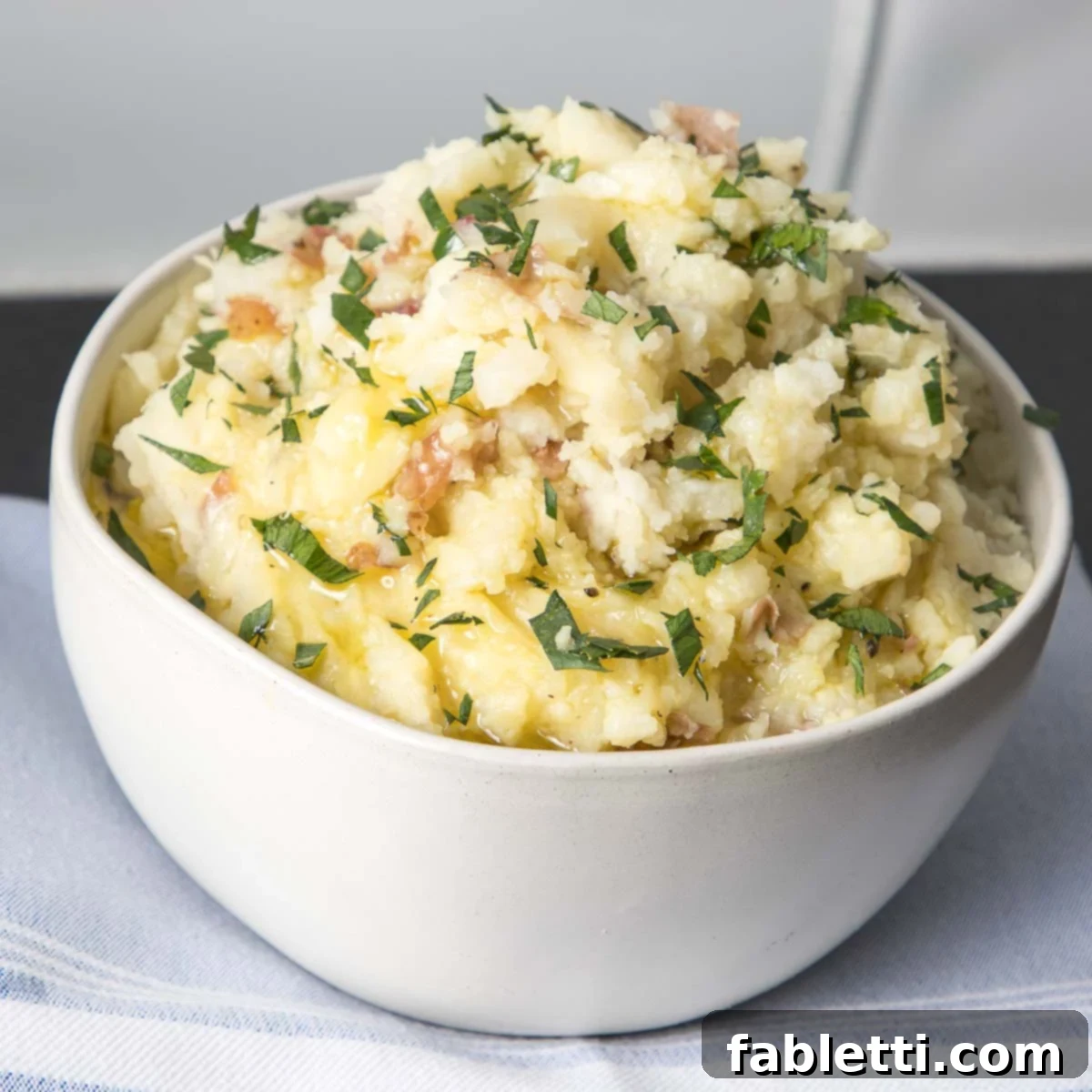These Dairy-free Garlic Mashed Potatoes are not just a dish; they’re a revelation. Imagine incredibly rich, wonderfully creamy, and perfectly light and fluffy mashed potatoes, bursting with savory garlic flavor, yet entirely suitable for a vegan diet. Yes, you heard that right! This healthy mashed potato recipe is an absolute dream come true, whether you’re planning a festive Thanksgiving dinner or simply seeking a comforting weeknight meal. And the taste? Absolutely incredible – a delightful experience for your taste buds!

This post has been meticulously updated and expanded from its original publication on November 1, 2015, to bring you even more valuable insights and tips for perfecting your dairy-free mashed potatoes.
Table of Contents
- The Appeal of Dairy-Free Garlic Mashed Potatoes
- Why Choose Dairy-Free? Health Benefits & Dietary Choices
- Selecting the Perfect Potatoes for Your Mash
- Beyond Potatoes: The Magic of Root Vegetables & Key Enhancers
- Step-by-Step Guide: Crafting Your Creamy Vegan Mash
- Expert Tips for Unbeatable Mashed Potatoes
- Make-Ahead & Storage Solutions for Effortless Entertaining
- Mastering Reheating: Keep Your Mash Creamy
- Perfect Pairings: What to Serve with Mashed Potatoes
- Full Dairy-Free Garlic Mashed Potatoes Recipe
The Appeal of Dairy-Free Garlic Mashed Potatoes: A Healthy Twist on a Classic Comfort Food
Mashed potatoes are undeniably a classic comfort food, conjuring images of warmth, family gatherings, and satisfying indulgence. But what if you could enjoy that beloved creamy texture and rich flavor without any dairy? Our vegan garlic mashed potatoes offer precisely that: the ultimate healthy comfort food experience! These aren’t just warm and satisfying; they’re also the perfect canvas for a generous pour of rich, golden vegan gravy, making every bite pure bliss.
This easy recipe for non-dairy mashed potatoes masterfully skips the heavy cream, coconut milk, and even most vegan butters, which often contain highly processed industrial seed or vegetable oils rich in Omega-6 fatty acids. Instead, we rely on a harmonious blend of flavorful root vegetables, an abundance of fresh garlic, high-quality olive oil, and robust vegetable broth. This thoughtful combination is what truly delivers an unparalleled depth of taste and luxurious texture. We confidently believe this is among the BEST vegan mashed potato recipes you’ll ever encounter.
Your entire family, including those who typically prefer traditional mashed potatoes, will adore this wholesome version of a classic side dish so much that you may never look back! Its exceptional flavor and creamy consistency stand up to any conventional recipe. What’s more, this classic side is wonderfully adaptable: it’s easy to prepare ahead of time and reheat, making it an ideal candidate for efficient meal prep, whether for your daily dinners or for grand special occasions like Thanksgiving dinner. Prepare to impress everyone with this delightfully healthy and utterly delicious dish!
Why Choose Dairy-Free? Health Benefits & Dietary Choices Explained
Embracing dairy-free mashed potatoes isn’t just a trend; it’s a mindful choice with numerous benefits that cater to a wide range of dietary needs and preferences. Whether you’re managing lactose intolerance, navigating dairy allergies, or simply opting for a plant-based lifestyle, this recipe proves that you don’t have to sacrifice flavor or texture.
For individuals with lactose intolerance, traditional mashed potatoes can lead to uncomfortable digestive issues. Our dairy-free version eliminates this concern entirely, allowing everyone to enjoy this comforting side dish without worry. Similarly, those with dairy allergies can partake in the meal safely, transforming a potentially restrictive dish into an inclusive one.
Beyond dietary restrictions, many choose plant-based options for health reasons. Swapping dairy for wholesome plant-based alternatives can contribute to a diet lower in saturated fat and cholesterol, while often increasing fiber intake, especially with the addition of nutrient-dense root vegetables. Our recipe utilizes olive oil, a heart-healthy fat, and vegetable broth to create richness, providing a cleaner and often lighter alternative to butter and cream. This approach doesn’t just make the dish healthier; it allows the natural, earthy flavors of the potatoes and root vegetables to shine through, creating a more nuanced and sophisticated taste profile that is both deeply satisfying and incredibly good for you.
Selecting the Perfect Potatoes for Your Unforgettable Mash
The type of potato you choose plays a crucial role in the final texture of your mashed potatoes. Each variety offers a unique characteristic, allowing you to tailor your mash to your personal preference. Understanding these differences is key to achieving your desired consistency, whether you prefer a rustic, chunky mash or an ultra-smooth, creamy creation.
- Red Bliss Potatoes: If you appreciate a mashed potato with a bit more character and texture, red bliss potatoes are an excellent choice. Many purists might argue that these waxy potatoes aren’t ideal for mashing, but I respectfully disagree! Their ability to hold their shape slightly after cooking results in a delightfully chunkier mash that I personally love. Beyond texture, red bliss potatoes are a healthier option, generally containing fewer carbs and calories while offering more essential vitamins and minerals compared to their starchier counterparts. Their vibrant red skins also add a beautiful, rustic visual appeal and extra fiber when left on.
- Yukon Gold Potatoes: For those seeking a rich color, smooth texture, and inherently buttery flavor, Yukon gold potatoes are the undeniable champion. These popular potatoes boast a naturally creamy consistency and a subtle sweetness that is simply divine, making them perfect for dairy-free mashed potatoes where a buttery note is desired without actually using butter. They mash beautifully into a smooth, fluffy, and luxurious consistency, living up to their reputation as the most popular recommendation for mashed potato perfection.
- Russet Potatoes: If your ultimate goal is the absolute creamiest, most ethereal mashed potatoes, russet potatoes are your go-to. Their high starch content means they break down easily when cooked, absorbing liquid readily and transforming into an incredibly smooth and fluffy mash. They deliver that classic, melt-in-your-mouth texture that many associate with traditional mashed potatoes.
- Idaho Potatoes: Very similar in characteristics and end result to russet potatoes, an Idaho potato is essentially a Russet potato specifically grown in Idaho. They share the same starchy profile, making them equally perfect for achieving exceptionally creamy mashed potatoes.
- Potatoes Not Ideal for Mashing: While delicious in other preparations, certain potato varieties are best avoided for mashing as they tend to become gummy or watery. These include fingerlings, new potatoes, baby potatoes, and blue potatoes, which often have a waxy texture that doesn’t break down well for mashing.
Ingredient Notes: The Secret to Depth, Texture, and Creaminess
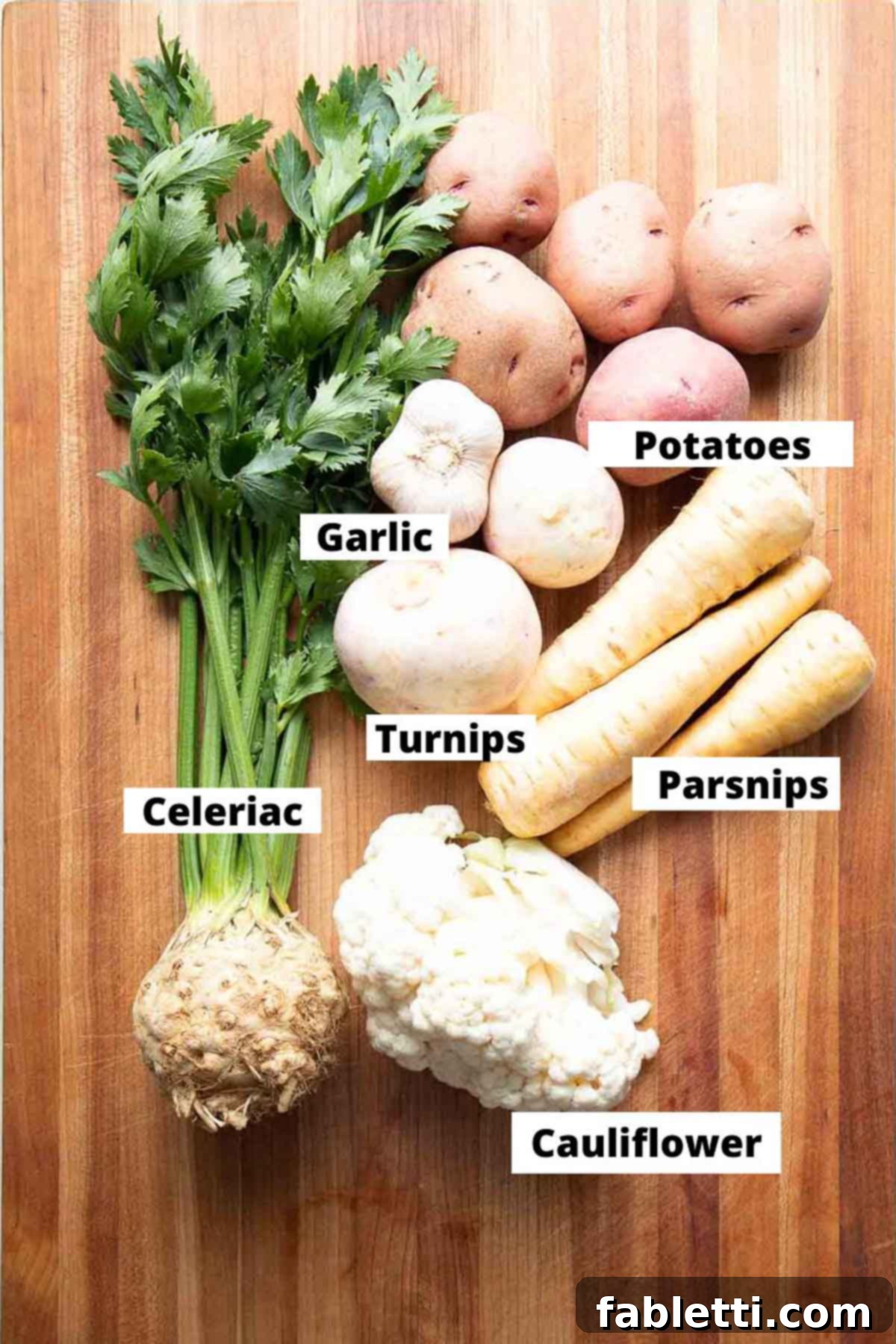
For years, I’ve found that incorporating other root vegetables into my mashed potatoes is one of the simplest yet most impactful ways to elevate both their health profile and their flavor complexity. This approach transforms a simple side dish into a vibrant blend of diverse vitamins and minerals, significantly boosting its fiber content. The best part? You still achieve the incredibly creamy texture you expect from the best mashed potatoes, but with added nutritional benefits and intriguing taste notes.
- Potatoes: As discussed above, select your preferred potato type based on your desired texture: red bliss for a chunkier, more rustic mash; Yukon gold for rich color, buttery flavor, and smooth fluffiness; or russet for the ultimate creamy experience.
- Cauliflower: A fantastic addition, cauliflower contributes significantly to the mash’s super creamy texture while simultaneously reducing the overall carbohydrate and calorie count. It blends seamlessly with potatoes, adding a subtle, mild flavor. To save time, you can easily substitute fresh cauliflower florets with pre-cut cauliflower rice or even frozen cauliflower. Just ensure frozen cauliflower is thawed slightly and well-drained before cooking to prevent excess water.
- Turnips: These often-overlooked root vegetables are nutritional powerhouses, incredibly high in fiber, vitamins K, A, C, and E, as well as essential minerals like potassium, magnesium, and calcium. Turnips introduce a unique flavor profile to the mash – a slightly bitter yet subtly spicy and earthy note that adds wonderful depth and complexity, preventing the dish from tasting one-dimensional.
- Celeriac (Celery Root): The fascinating root part of the celery plant, celeriac offers a distinctive, nutty, and slightly earthy flavor that provides a natural boost to the overall taste of your mashed potatoes. Its texture is similar to a potato when cooked, making it an ideal blending companion. Remember to use the root for the mash, but don’t discard the leafy tops! They can be finely chopped and sprinkled as a fresh garnish on your finished mash or even added to your favorite Thanksgiving stuffing for extra flavor.
- Parsnips: With their creamy texture and distinctive flavor, parsnips bring a delightful combination of sweet, spicy, and nutty notes to the mash. When cooked, their natural sugars caramelize slightly, adding a comforting warmth and a touch of sweetness that balances the earthiness of the other roots.
Elevating Flavor: Beyond the Basics for an Irresistible Mash
While the combination of potatoes and root vegetables forms a delicious base, certain key ingredients truly elevate these dairy-free mashed potatoes from good to extraordinary. These flavor enhancers are carefully selected to provide richness, depth, and that coveted “umami” without relying on traditional dairy products.
- Garlic: This is a not-so-secret ingredient that truly defines our “Vegan Garlic Mashed Potatoes”! Garlic cloves are boiled directly with the potatoes and root vegetables. This method is crucial: as they cook, the garlic mellows significantly, losing its raw pungency and bitterness, and instead infusing the entire dish with a sweet, aromatic, and deeply savory flavor. It also makes them incredibly easy to mash, seamlessly blending into the creamy texture. Feel free to be generous with the garlic – the more you add, the richer and more irresistible your mash will be!
- Olive Oil: Instead of butter, we opt for high-quality olive oil. Not only is it a healthier alternative, being significantly lower in saturated fat, but it also adds just the right amount of luxurious creaminess and a subtle, herbaceous note that complements the other ingredients beautifully. My personal choice to avoid many vegan butters stems from their common inclusion of highly processed industrial seed or vegetable oils, which are often too rich in Omega-6 fatty acids and can detract from a truly healthy dish. Olive oil provides a clean, wholesome richness that feels indulgent without compromise.
- Vegetable Stock (or Broth): The liquid component in our mashed potatoes is vegetable stock, which is paramount for both hydration and flavor. I highly recommend making your vegetable broth from scratch. It’s an easy process that allows you to concentrate the flavors to your liking and maintain complete control over the ingredients, ensuring no unwanted additives. This homemade approach yields a far more robust and nuanced flavor than many store-bought options. If you opt for store-bought broth, be sure to read labels meticulously. Look for low-sodium varieties and brands that explicitly state no added processed oils or excessive sodium, which can overwhelm the delicate balance of flavors in your mash. This is a far superior choice to chicken stock, ensuring your mashed potatoes remain truly vegan and bursting with vegetable goodness.
How to Make Perfectly Creamy Mashed Potatoes Without Dairy: A Step-by-Step Guide
Creating these rich and flavorful dairy-free mashed potatoes is a straightforward process. Follow these steps for an incredibly satisfying dish:

Step 1: Prepare Your Vegetables. Begin by thoroughly scrubbing your potatoes. There’s no need to peel them; leaving the skins on adds valuable fiber, vitamins, and a lovely rustic texture to the mash. Cut the scrubbed potatoes into large, uniform cubes. Next, peel the parsnips, turnips, and celeriac. Chop these root vegetables into pieces roughly the same size as your potato cubes to ensure even cooking. Finally, cut your cauliflower into florets and peel the garlic cloves, leaving them whole.
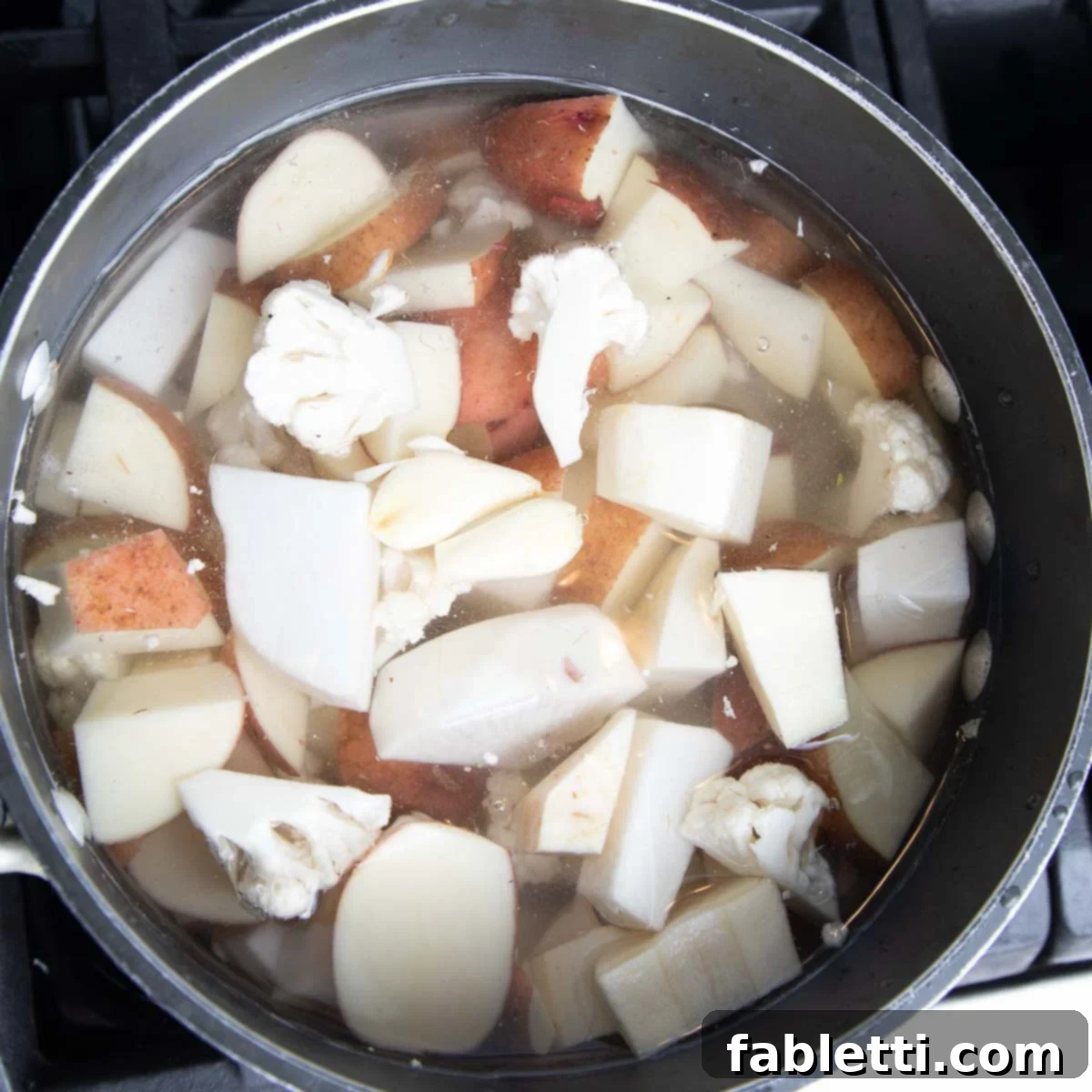
Step 2: Cook the Vegetables. Place all the prepared vegetables and whole peeled garlic cloves into a large pot. Cover them with water, ensuring there are about 2 inches of water above the vegetables. Bring the pot to a rolling boil over high heat, then reduce the heat to a gentle simmer. Cook, uncovered, for approximately 20 minutes, or until all the vegetables are super tender and easily pierced with a fork. While your vegetables are cooking, take a moment to heat your vegetable stock in a small saucepan on the side and keep it warm. This ensures it’s ready to be incorporated without cooling down your mash.

Step 3: Drain and Dry. Once the vegetables are perfectly tender, carefully drain them in a colander. It’s a good idea to reserve about ¼ cup of the starchy cooking water – this can be used later if you find your mash needs a little extra liquid and you’ve run out of vegetable stock. Return the drained vegetables to the same hot pot. Gently shake the pot over low heat for a minute or two to allow any remaining surface water to evaporate. This crucial step helps prevent watery mashed potatoes and ensures a creamier texture.
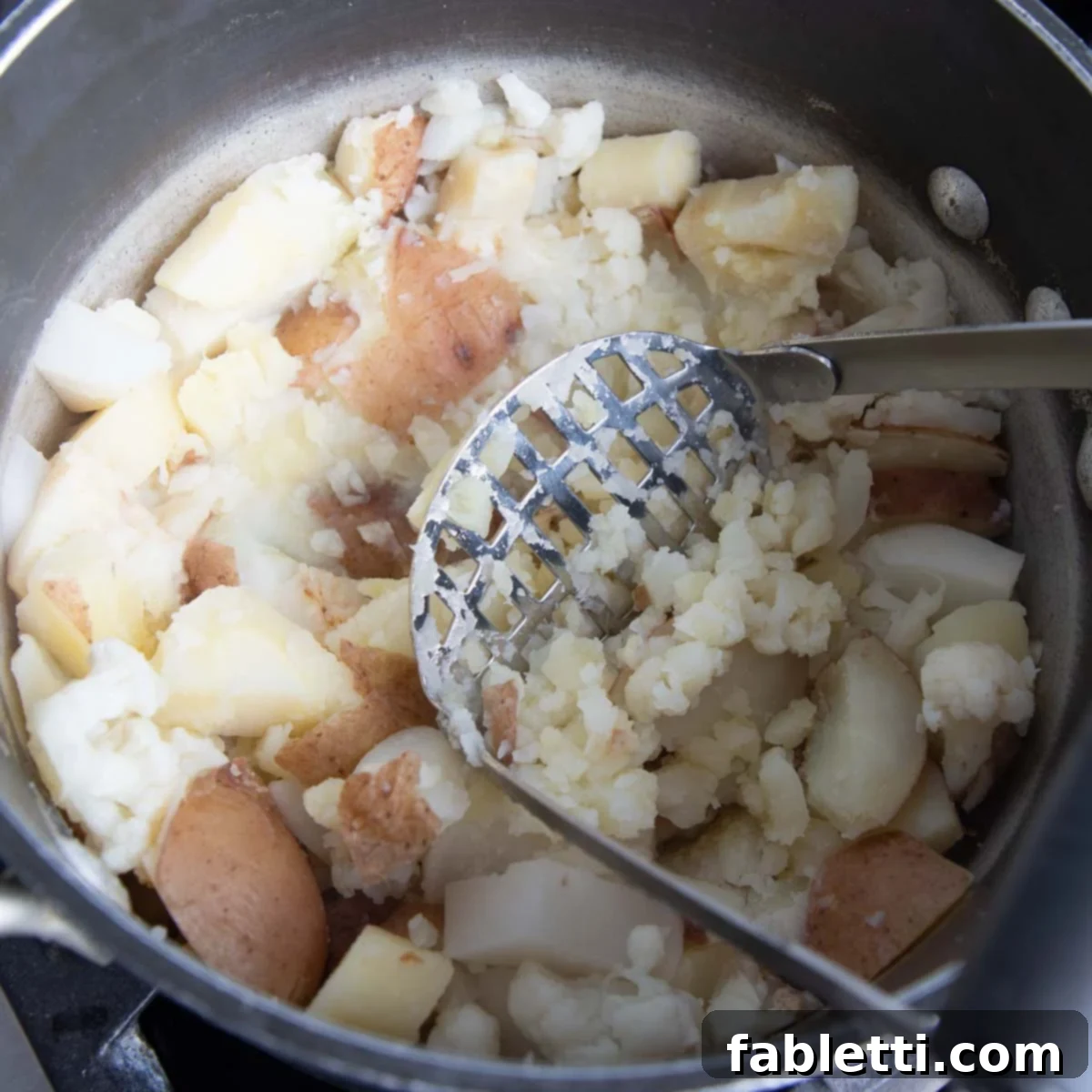
Step 4: Mash to Perfection. Now for the mashing! Place the boiled vegetables back into the same pot. I personally prefer to use a potato masher, leaving some delightful chunks for added texture and a more rustic feel. If you desire a super smooth and velvety texture, an immersion blender will achieve this quickly. For the absolute best fluffy texture, often preferred by many, consider using a potato ricer or an electric hand mixer.
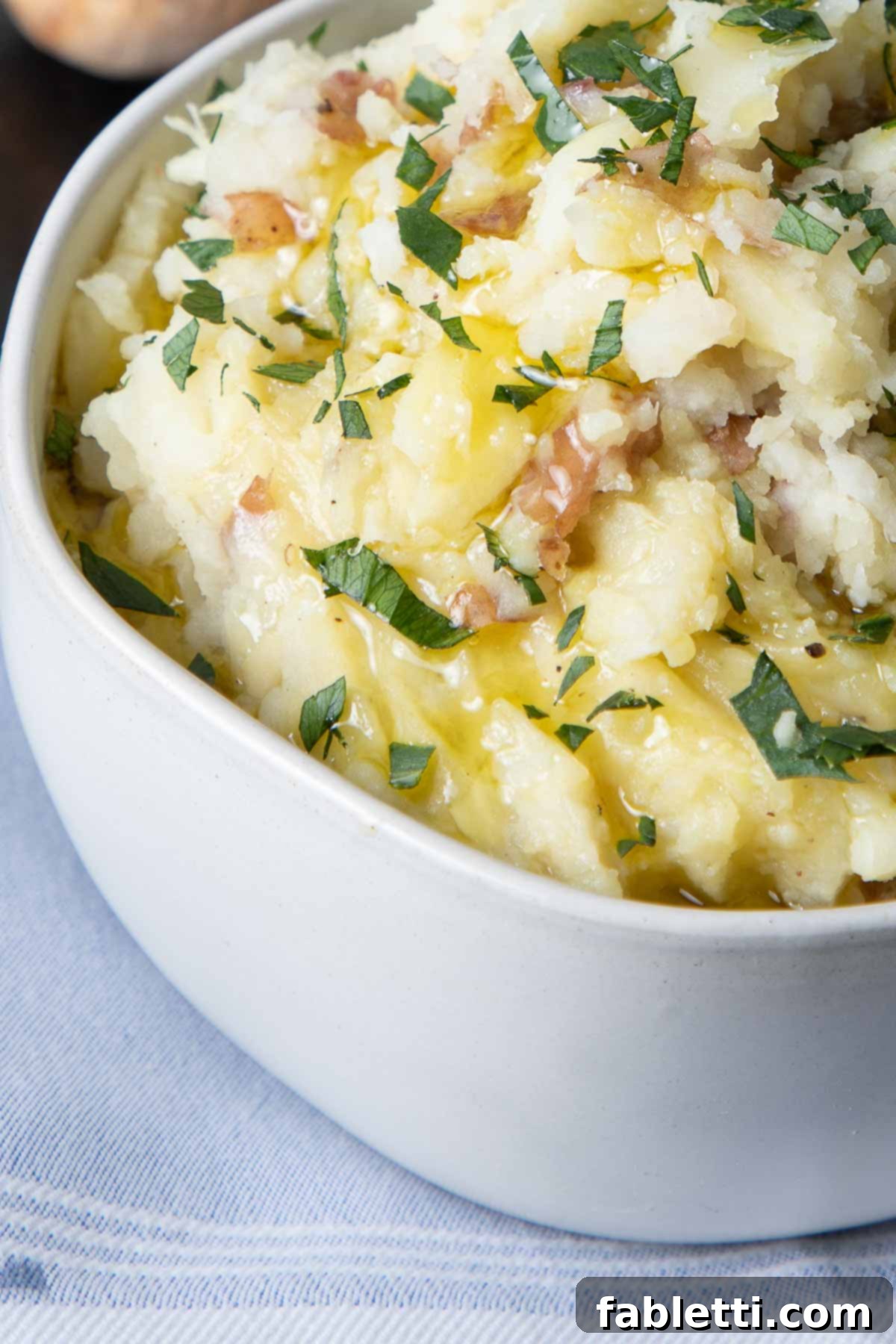
- Step 5: Season and Incorporate Liquids. Drizzle in the olive oil, along with a teaspoon of salt and ½ teaspoon of freshly ground black pepper. Continue to mash or blend until everything is well combined and reaches your desired consistency. Remember, some chunks can add an interesting textural contrast.
- Step 6: Achieve Desired Creaminess. Slowly pour in the warm vegetable stock, starting with ¼ cup. Mix thoroughly and check the consistency. Continue adding the remaining broth, 1 tablespoon at a time, until the mashed potatoes reach your desired creaminess. If you run out of stock and still need a touch more liquid, use the reserved starchy cooking water.
- Step 7: Final Seasoning and Garnish. Taste the mashed potatoes and adjust the seasoning as needed. Add more salt and pepper to suit your palate, mixing well to distribute. For a fresh finish and a burst of color, sprinkle with freshly chopped parsley, vibrant green onions, or even delicate celery leaves.
- Step 8: Storage. To store any leftover mashed potatoes, transfer them to an airtight container. They will keep beautifully in the refrigerator for up to a week, or you can freeze them for up to 3 months for longer preservation.
Expert Tips for Unbeatable Dairy-Free Mashed Potatoes
Achieving truly spectacular mashed potatoes, especially without dairy, often comes down to a few insider tricks. Here are my go-to professional tips to ensure your dairy-free garlic mashed potatoes are consistently perfect every single time:
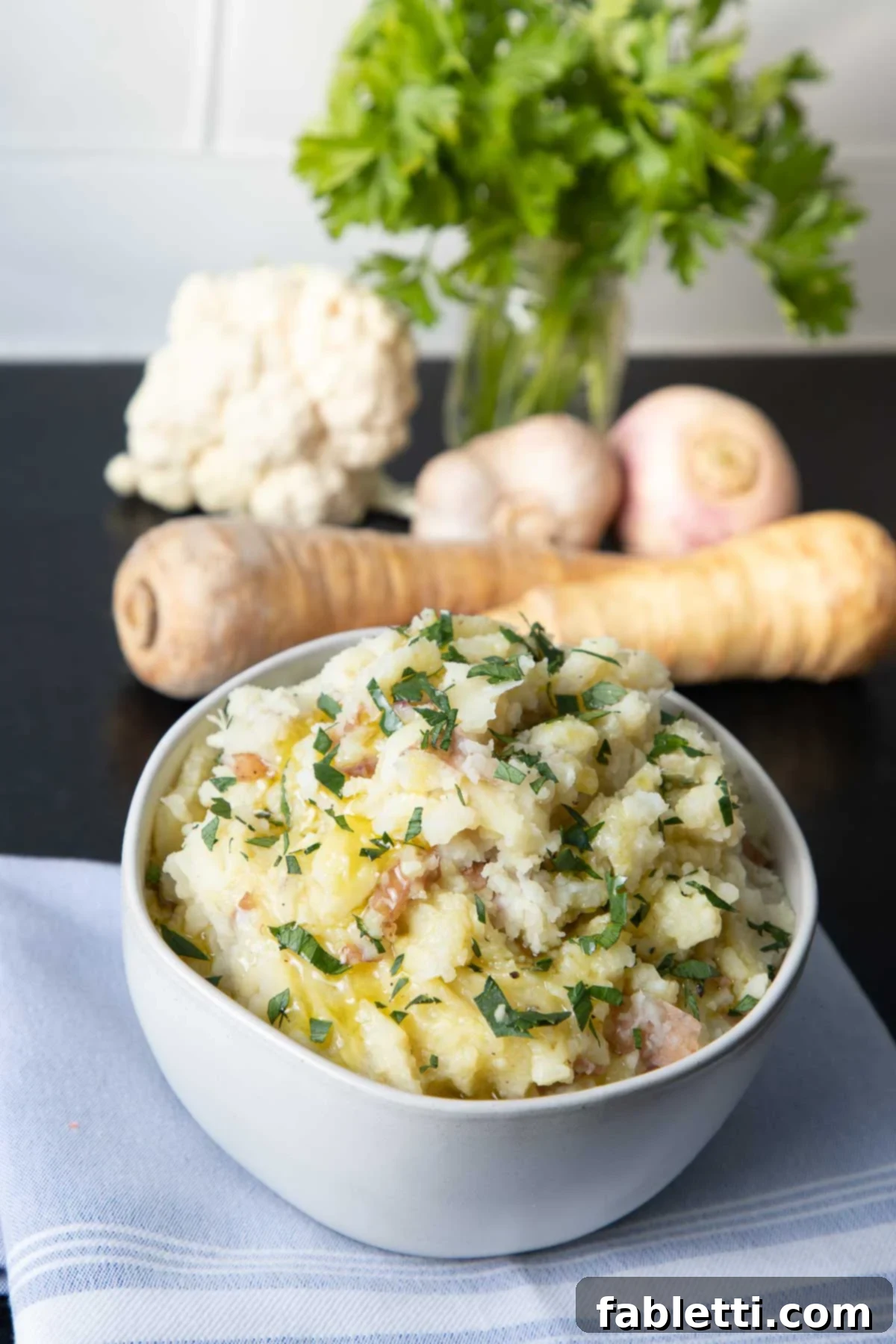
- Embrace the Skins: The Loofah Trick! When you’re not peeling your potatoes (and I highly recommend leaving the skins on for their extra fiber, vitamins, and minerals!), a simple loofah can make scrubbing a breeze. Its textured surface effectively cleans the potato skins without removing too much of the beneficial outer layer.
- Mash in a Hot Pot: After draining your cooked potatoes and roots, immediately return them to the same hot pot. Giving them a quick shake over low heat for a minute or two helps to evaporate excess surface water. Mashing them in the still-warm pot also helps retain their heat, which is essential for achieving a consistently smooth and creamy texture while preventing them from becoming cold and dense.
- The Golden Rule: Do Not Overmix! This is perhaps the most critical tip for any mashed potato recipe. Regardless of whether you’re using a potato masher, an immersion blender, a ricer, or a hand mixer, be incredibly mindful of how much you mix. Overmixing potatoes can break down their starch cells too much, releasing excessive starch and resulting in a gluey, unappetizing texture rather than a fluffy one. Mash just enough until your desired consistency is reached.
- Thanksgiving Prep Masterclass: For the best Thanksgiving Mashed Potatoes and Gravy experience, prepare your mashed potatoes up to 3 hours in advance. Transfer them to a slow cooker and set it to the “warm” setting. This keeps them perfectly hot and creamy without drying out, freeing up valuable stove space and your time for other last-minute tasks. Alternatively, you can place them in a covered bowl balanced over a pot of barely simmering water (a DIY double boiler). Your vegan gravy can also be made up to a week in advance and gently reheated on the stove before serving, further streamlining your holiday cooking.
- Potato Alternative: Mashed Acorn Squash: Love the concept of a good mash but looking for something beyond potatoes? Explore Roasted and Mashed Acorn Squash. It offers a wonderful blend of savory and sweet flavors, providing a delightful and equally comforting side dish with a unique twist.
Make-Ahead & Storage: Enjoy Mashed Potatoes Anytime
The beauty of these dairy-free garlic mashed potatoes extends to their convenience. They are an excellent make-ahead dish, perfect for busy weeknights or stress-free holiday entertaining. My preferred method is to prepare them fully on the same day I plan to serve them, but several hours in advance. I then transfer them to a crock pot and set it to the “warm” setting. This allows the mashed potatoes to retain their exquisite creamy texture and remain perfectly hot, ready to be served exactly when needed. If you’re hosting a buffet, this method is even better: no need to transfer to another serving dish, and you can keep them warm throughout the meal. It’s a win-win – no last-minute rush, and consistently delicious, hot mashed potatoes!
For longer storage, once cooled, place leftovers in an airtight container in the refrigerator for up to a week. For even longer preservation, they can be frozen for up to 3 months. If your mashed potatoes were frozen, always defrost them in the refrigerator overnight before reheating. This allows you to give them a good stir and helps prevent uneven heating or scorching during the reheating process. Remember that reheating time will vary significantly based on the quantity of potatoes and the depth of the pan, pot, or bowl you are using. Be sure to stir frequently, reaching all the way to the bottom of the pan, to ensure even heating and prevent burning.
How to Perfectly Reheat Mashed Potatoes: Maintaining Creaminess and Flavor
Reheating mashed potatoes can sometimes be tricky, often leading to dry or lumpy results. However, with the right technique, you can restore them to their original creamy glory. Here are several effective methods:
- On the Stovetop (Double Boiler Method): This is arguably the gentlest method for reheating and best for preserving texture. Place your mashed potatoes in a heatproof bowl. Set this bowl over a saucepan containing about an inch or two of barely simmering water (ensure the bottom of the bowl does not touch the water). If you own a double boiler, now is its time to shine! As the potatoes warm through, gently stir them. If they appear a bit dry, add a couple of tablespoons of warm vegetable broth, stirring until absorbed. Cover with foil and leave over the simmering water until you’re ready to serve.
- In the Oven: Preheat your oven to 325°F (160°C). Stir the cold mashed potatoes thoroughly, then mix in 1-2 tablespoons of vegetable broth to introduce moisture. For an extra touch of richness and tang, you could optionally add 2 tablespoons of vegan sour cream instead of broth. Transfer the mashed potatoes to a baking dish and cover it tightly with foil. This creates a steaming environment, keeping them moist. Heat for about 25 minutes, or until thoroughly warmed through.
- In the Microwave: For a quick reheat, ensure your mashed potatoes are in a microwave-safe bowl. Sprinkle 2 tablespoons of vegetable broth over them, then cover the bowl with a moist paper towel. Microwave on high for 2 minutes. Stir well, then microwave for another 2 minutes. Continue this process, stirring after each interval, until the mashed potatoes are evenly heated throughout. Add another 1-2 tablespoons of broth if they start to look dry.
- In the Slow Cooker: If you have ample time, the slow cooker is fantastic for reheating larger batches. Cook on low for 1-2 hours with the lid on, stirring once or twice during the process. If needed, sprinkle with 1-2 tablespoons of vegetable broth to maintain moisture and creaminess.
- Creative Uses for Leftover Mashed Potatoes: Don’t let a single scoop go to waste! Leftover mashed potatoes are incredibly versatile. Transform them into crispy mashed potato waffles, add a delicious layer to a Thanksgiving sandwich, use them to top a savory vegan shepherd’s pie, or even bulk up and thicken a pureed soup for added creaminess and substance.
What to Serve with Your Dairy-Free Garlic Mashed Potatoes
These versatile dairy-free garlic mashed potatoes make a fantastic accompaniment to a wide array of main courses and other side dishes. Their creamy texture and savory garlic notes complement everything from hearty roasts to lighter vegetable preparations. Here are some of my favorite pairings to create a truly memorable meal:
- Easy Vegan Gravy Recipe:The ultimate companion! A rich, savory vegan gravy poured generously over your mashed potatoes is pure comfort food bliss. This recipe is simple to make and incredibly flavorful.
- Vegan Meatloaf Recipe:A classic pairing. The hearty, savory flavors of a vegan meatloaf create a perfectly balanced and satisfying meal when served alongside creamy mashed potatoes.
- Easy Recipe for Green Beans with Almonds:A crisp, fresh, and vibrant side that adds a lovely textural contrast to the soft mashed potatoes. The subtle nuttiness of the almonds perfectly complements the garlic.
- Vegan Mushroom Stroganoff Recipe:Rich and decadent, this creamy mushroom stroganoff finds its ideal partner in mashed potatoes, creating a truly comforting and deeply flavorful meal that’s perfect for chilly evenings.
Did you know that leaving a comment and rating recipes is one of the most impactful ways to support your favorite food bloggers? If you enjoyed this recipe for Dairy-Free Garlic Mashed Potatoes, please consider leaving a five-star rating below and sharing your thoughts in a comment. I would also absolutely love to see your culinary creations! Please share your photos on Instagram by tagging me @dkhealthcoach and using the hashtag #debraklein. Your support means the world!
📖 Full Recipe: Dairy-Free Garlic Mashed Potatoes
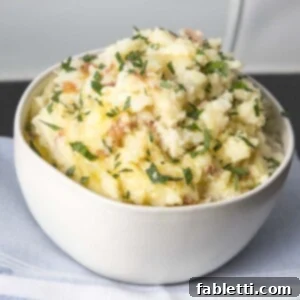
Dairy-Free Garlic Mashed Potatoes
Debra Klein
Average Rating: 5 stars from 71 votes
Rate this Recipe
Pin Recipe
7 mins
20 mins
3 mins
30 mins
Side Dish
American
6 servings
196 kcal
Ingredients
- 1 ½ lbs potatoes (scrubbed, skins on)
- 2 medium sized parsnips (peeled)
- 2 medium purple turnips (peeled)
- 1 small celeriac (peeled)
- ½ small cauliflower (or 12 oz bag if using frozen)
- 6 cloves garlic (peeled)
- ½ cup vegetable broth
- 2 Tablespoons olive oil
- 1 teaspoon salt
- ½ teaspoon freshly ground black pepper
- ¼ cup chopped fresh parsley (to garnish)
Instructions
- PREP Veggies: Scrub potatoes thoroughly (no need to peel, the skins add great texture and nutrition). Peel parsnips, turnips, and celeriac. Roughly chop all vegetables, including the cauliflower florets, into approximately the same size pieces for even cooking. Peel garlic cloves and leave them whole.
- Place all the prepared vegetables and peeled whole garlic cloves in a large pot and cover them with water by about 2 inches.
- Bring the water to a full boil, then reduce the heat to a gentle simmer. Cook, uncovered, for about 20 minutes, or until all the vegetables are very tender and easily pierced with a fork.
- Meanwhile, gently heat the vegetable stock in a small saucepan and keep it warm.
- Once tender, carefully drain the cooked vegetables, reserving ¼ cup of the starchy cooking liquid. This reserved liquid can be used later if additional moisture is needed.
- Return the cooked vegetables to the hot pot. Use a potato masher to evenly mash the mixture. I prefer to leave some small chunks for a more rustic texture. For exceptionally smooth mashed potatoes, an immersion blender works best.
- Drizzle the olive oil and sprinkle the salt and pepper onto the mashed vegetables, continuing to mash or blend until thoroughly combined. Gradually add the warm vegetable stock, 1 tablespoon at a time, until you achieve your desired creamy consistency. If the potatoes still seem dry after adding all the stock, use the reserved cooking liquid 1 tablespoon at a time.
- Taste for seasoning and adjust by adding more salt and pepper as needed to enhance the flavors. Mix well.
- For a final touch, sprinkle with fresh chopped parsley before serving.
Notes
VEGGIE BROTH: Here’s an easy recipe for homemade veggie broth. Consider freezing it in ice cube trays; this allows you to defrost precisely the amount you need, minimizing waste. If you opt for store-bought broth, always choose a low-sodium variety and carefully check the label for brands that do not contain added processed oils, which can compromise the flavor and health benefits.
KEEP MASHED POTATOES WARM: The simplest and most effective ways to keep your mashed potatoes warm and perfectly creamy until serving are to either transfer them to a slow cooker set on “warm,” or place a covered bowl of mash over a pot of barely simmering water (a DIY double boiler).
REHEAT MASHED POTATOES: To refresh your mashed potatoes during reheating, consider adding 1-2 tablespoons of vegan sour cream (if available) and mixing thoroughly before heating. Refer to the detailed reheating methods section in the post above for various techniques.
Nutrition
Serving:
1
g
Calories:
196
kcal
Carbohydrates:
32
g
Protein:
5
g
Fat:
5
g
Saturated Fat:
1
g
Polyunsaturated Fat:
4
g
Sodium:
450
mg
Fiber:
5
g
Sugar:
5
g
Note
The nutrition calculations provided here were performed using online tools. To ensure the most accurate representation of the nutritional information for any given recipe, it is recommended that you calculate the nutritional information using the exact ingredients you have used. You are ultimately responsible for verifying that any nutritional information you rely upon is accurate, complete, and useful for your dietary needs.
Did you make this recipe?
Please leave a review below, then snap a picture and tag me @dkhealthcoach or use hashtag #dkhealtcoach on Instagram so I can see it!!
